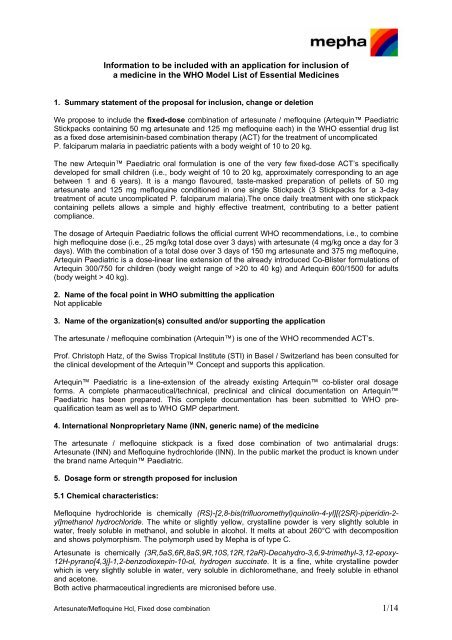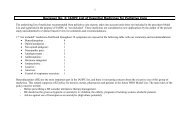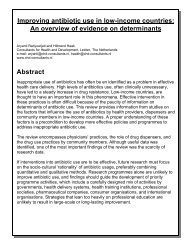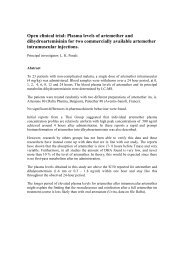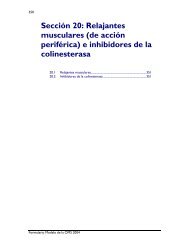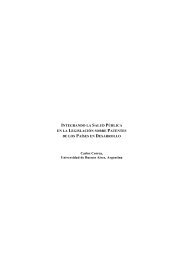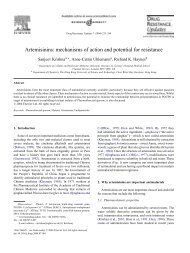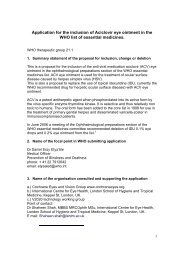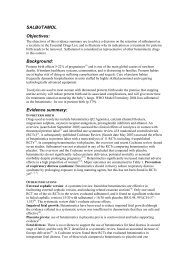Artesunate + mefloquine fixed-dose combination
Artesunate + mefloquine fixed-dose combination
Artesunate + mefloquine fixed-dose combination
You also want an ePaper? Increase the reach of your titles
YUMPU automatically turns print PDFs into web optimized ePapers that Google loves.
Information to be included with an application for inclusion of<br />
a medicine in the WHO Model List of Essential Medicines<br />
1. Summary statement of the proposal for inclusion, change or deletion<br />
We propose to include the <strong>fixed</strong>-<strong>dose</strong> <strong>combination</strong> of artesunate / <strong>mefloquine</strong> (Artequin Paediatric<br />
Stickpacks containing 50 mg artesunate and 125 mg <strong>mefloquine</strong> each) in the WHO essential drug list<br />
as a <strong>fixed</strong> <strong>dose</strong> artemisinin-based <strong>combination</strong> therapy (ACT) for the treatment of uncomplicated<br />
P. falciparum malaria in paediatric patients with a body weight of 10 to 20 kg.<br />
The new Artequin Paediatric oral formulation is one of the very few <strong>fixed</strong>-<strong>dose</strong> ACT’s specifically<br />
developed for small children (i.e., body weight of 10 to 20 kg, approximately corresponding to an age<br />
between 1 and 6 years). It is a mango flavoured, taste-masked preparation of pellets of 50 mg<br />
artesunate and 125 mg <strong>mefloquine</strong> conditioned in one single Stickpack (3 Stickpacks for a 3-day<br />
treatment of acute uncomplicated P. falciparum malaria).The once daily treatment with one stickpack<br />
containing pellets allows a simple and highly effective treatment, contributing to a better patient<br />
compliance.<br />
The dosage of Artequin Paediatric follows the official current WHO recommendations, i.e., to combine<br />
high <strong>mefloquine</strong> <strong>dose</strong> (i.e., 25 mg/kg total <strong>dose</strong> over 3 days) with artesunate (4 mg/kg once a day for 3<br />
days). With the <strong>combination</strong> of a total <strong>dose</strong> over 3 days of 150 mg artesunate and 375 mg <strong>mefloquine</strong>,<br />
Artequin Paediatric is a <strong>dose</strong>-linear line extension of the already introduced Co-Blister formulations of<br />
Artequin 300/750 for children (body weight range of >20 to 40 kg) and Artequin 600/1500 for adults<br />
(body weight > 40 kg).<br />
2. Name of the focal point in WHO submitting the application<br />
Not applicable<br />
3. Name of the organization(s) consulted and/or supporting the application<br />
The artesunate / <strong>mefloquine</strong> <strong>combination</strong> (Artequin) is one of the WHO recommended ACT’s.<br />
Prof. Christoph Hatz, of the Swiss Tropical Institute (STI) in Basel / Switzerland has been consulted for<br />
the clinical development of the Artequin Concept and supports this application.<br />
Artequin Paediatric is a line-extension of the already existing Artequin co-blister oral dosage<br />
forms. A complete pharmaceutical/technical, preclinical and clinical documentation on Artequin<br />
Paediatric has been prepared. This complete documentation has been submitted to WHO prequalification<br />
team as well as to WHO GMP department.<br />
4. International Nonproprietary Name (INN, generic name) of the medicine<br />
The artesunate / <strong>mefloquine</strong> stickpack is a <strong>fixed</strong> <strong>dose</strong> <strong>combination</strong> of two antimalarial drugs:<br />
<strong>Artesunate</strong> (INN) and Mefloquine hydrochloride (INN). In the public market the product is known under<br />
the brand name Artequin Paediatric.<br />
5. Dosage form or strength proposed for inclusion<br />
5.1 Chemical characteristics:<br />
Mefloquine hydrochloride is chemically (RS)-[2,8-bis(trifluoromethyl)quinolin-4-yl][(2SR)-piperidin-2yl]methanol<br />
hydrochloride. The white or slightly yellow, crystalline powder is very slightly soluble in<br />
water, freely soluble in methanol, and soluble in alcohol. It melts at about 260°C with decomposition<br />
and shows polymorphism. The polymorph used by Mepha is of type C.<br />
<strong>Artesunate</strong> is chemically (3R,5aS,6R,8aS,9R,10S,12R,12aR)-Decahydro-3,6,9-trimethyl-3,12-epoxy-<br />
12H-pyrano[4,3j]-1,2-benzodioxepin-10-ol, hydrogen succinate. It is a fine, white crystalline powder<br />
which is very slightly soluble in water, very soluble in dichloromethane, and freely soluble in ethanol<br />
and acetone.<br />
Both active pharmaceutical ingredients are micronised before use.<br />
<strong>Artesunate</strong>/Mefloquine Hcl, Fixed <strong>dose</strong> <strong>combination</strong> 1/14
5.2 The formulation proposed for inclusion:<br />
The dosage form is constituted of pellets and a powder mixture filled in stickpacks. Each stickpack<br />
contains 50 mg <strong>Artesunate</strong> and 125 mg Mefloquine (corresponding to 137 mg Mefloquine<br />
hydrochloride) as drug substances.<br />
<strong>Artesunate</strong> plus Mefloquine is one of the three WHO-recommended ACTs to treat uncomplicated P.<br />
falciparum malaria.<br />
The <strong>Artesunate</strong>/ Mefloquine stickpack is an innovative <strong>fixed</strong>-<strong>dose</strong> ACT, especially developed for small<br />
children (10-20 kg). This <strong>fixed</strong>-<strong>dose</strong> <strong>combination</strong> was developed to ensure that patients take both<br />
drugs together in the right <strong>dose</strong>, with a particular attention paid to paediatric needs:<br />
- no water is needed to apply the pellets<br />
- the dosing scheme is easy and simple: 1 <strong>fixed</strong> <strong>dose</strong> daily for 3 days<br />
- the drug is easy to swallow, with a pleasant taste of mango<br />
5.3 Stability of the formulation<br />
Currently, three scale batches of <strong>Artesunate</strong> 50 mg / Mefloquine 125 mg Stickpacks are subject to a<br />
full stability programme including accelerated testing at 40°C / 75% RH.<br />
Based on the stability data obtained over a period of up to 12 months and the supportive date of the<br />
development batches a provisional shelf-life of 18 months can be presumed for the preparation<br />
<strong>Artesunate</strong> 50 mg / Mefloquine 125 mg stickpacks when it is stored below 25°C.<br />
Three production scale batches will be subject to a full stability programme.<br />
The stability studies on all mentioned batches will be continued up to the proposed end of shelf-life of<br />
36 months.<br />
6. International availability –sources, if possible manufacturers<br />
6.1 Sources of the active ingredients:<br />
Mefloquine HCl is manufactured by:<br />
CILAG AG<br />
Hochstr. 201<br />
CH-8205<br />
Switzerland<br />
<strong>Artesunate</strong> is manufactured by<br />
IPCA Laboratories Ltd.<br />
P.O Sejavta<br />
Dist. Ratlam<br />
Pin: 457 002<br />
India<br />
Or alternatively by<br />
Cambrex Profarmaco Landen<br />
Industriepark Roosvelt 2, B6<br />
3400 Landen<br />
Belgium<br />
<strong>Artesunate</strong>/Mefloquine Hcl, Fixed <strong>dose</strong> <strong>combination</strong> 2/14
6.2 Manufacturer of the finished product:<br />
The <strong>fixed</strong> <strong>dose</strong> <strong>combination</strong> of <strong>Artesunate</strong>/ Mefloquine HCl is manufactured by Mepha Ltd. in its<br />
manufacturing plant:<br />
Dornacherstrasse 114<br />
4147 Aesch<br />
Switzerland<br />
The manufacturer is certified as GMP compliant by its local authorities.<br />
A WHO inspection was also carried out from 25 to 27 April 2005 and the manufacturer was compliant<br />
with the principles and guidelines of WHO Good Manufacturing Practices.<br />
7. Whether listing is requested as an individual medicine or as an example of a therapeutic<br />
group<br />
<strong>Artesunate</strong> / Mefloquine <strong>fixed</strong>-<strong>dose</strong> <strong>combination</strong> (Artequin Paediatric Stickpacks containing 50 mg<br />
artesunate and 125 mg <strong>mefloquine</strong> each) should be listed in the WHO essential drug list within the<br />
pharmacotherapeutic group “antimalarial medicines for curative treatment”.<br />
8. Information supporting the public health relevance (epidemiological information on disease<br />
burden, assessment of current use, target population)<br />
Malaria is the most important of all tropical diseases and despite considerable efforts to eradicate or<br />
control the disease, malaria continues to be a major cause of human morbidity and mortality in the<br />
tropics, particularly in Africa and South-East Asia. Worldwide prevalence of the disease is estimated to<br />
be in the order of 300-500 million clinical cases each year and more than 90% of all malaria cases are<br />
in sub-Saharan Africa.<br />
In fact, out of more than 1 million deaths due to malaria in endemic regions each year, more than 80%<br />
occur in Africa south of the Sahara and over 75% occur in African children under 5 years infected with<br />
Plasmodium falciparum. About 1 in 5 (approx. 18%) of all childhood deaths in African is due to malaria<br />
resulting in one child’s death due to malaria every 30 seconds. In addition, an even greater proportion<br />
of child deaths is indirectly related to malaria: malaria infections contribute to the development of<br />
severe anaemia and make young children more susceptible to severe outcomes of common illnesses<br />
such as diarrhoea and respiratory diseases.<br />
Treatment of Plasmodium falciparum malaria in Africa is increasingly difficult. Resistance to cheap<br />
efficient antimalarial drugs poses an increasing threat.This is especially worrying in West Africa, where<br />
many health services depend on chloroquine as the first-line treatment of uncomplicated malaria,<br />
despite chloroquine resistance becoming more common.<br />
WHO, on the advice of international experts, recommends the introduction of <strong>combination</strong>s of drugs to<br />
replace single drugs in the treatment of Plasmodium falciparum malaria. WHO recommends in<br />
particular the use of drug <strong>combination</strong>s containing the peroxidic antimalarial artemisinin (derived from<br />
the herb Artemisia annua) and its derivatives such as artesunate, i.e., artemisinin-based <strong>combination</strong><br />
therapies (ACT), which provide an immediate solution to the problem of drug resistance.<br />
These recommendations led to the selection of two highly potent ACT partner drugs, namely<br />
artesunate and <strong>mefloquine</strong>, as active ingredients of Artequin Co-blister tablets as well as the <strong>fixed</strong><strong>dose</strong><br />
<strong>combination</strong> (FDC) of Artequin Paediatric Stickpacks.<br />
9. Treatment details (dosage regimen, duration; reference to existing WHO and other clinical<br />
guidelines; need for special diagnostic or treatment facilities and skills)<br />
Posology and method of administration:<br />
Patients with a body weight between 10 and 20 kg<br />
A treatment course with Artequin Paediatric comprises 3 stickpacks, each containing 50 mg<br />
artesunate and 125 mg <strong>mefloquine</strong>. One stickpack is to be taken once daily for 3 consecutive days.<br />
<strong>Artesunate</strong>/Mefloquine Hcl, Fixed <strong>dose</strong> <strong>combination</strong> 3/14
The first stickpack is given at the time of initial diagnosis, followed by a second stickpack 24 hours<br />
thereafter and a third (last) stickpack 48 hours after the initial one.<br />
If any Artequin Paediatric daily <strong>dose</strong> (1 stickpack) is missed, the patient should be advised to take the<br />
missed <strong>dose</strong> as soon as it is realised that it has been forgotten. Then the next <strong>dose</strong> should be taken<br />
after a further 24 hour interval.<br />
Patients who vomit within 1 hour after administration of any Artequin Paediatric daily <strong>dose</strong> (1<br />
stickpack) should be given a replacement (full) <strong>dose</strong>. In this case, the prescription of another Artequin<br />
Paediatric box should be considered. Parts of this new box may be used to ensure that the patient will<br />
complete a 3-day full treatment course with Artequin Paediatric.<br />
The <strong>combination</strong> of artesunate and <strong>mefloquine</strong> can also be used to treat malaria caused by mixed<br />
Plasmodium pathogens. Following treatment with Artequin of malaria caused by a mixed infection with<br />
P. vivax, relapse prophylaxis with an 8-aminoquinoline derivative (e.g. primaquine) should be<br />
considered to eliminate hepatic forms of the parasite.<br />
Patients with more than 20 kg body weight<br />
For these patients higher Artequin dosage regimens are recommended depending on the body weight.<br />
Patients with less than 10 kg body weight<br />
Artequin Paediatric is not recommended for use in patients who have less than 10 kg body weight.<br />
Method of administration<br />
Just before administration, the Artequin Paediatric stickpack should be opened (following the preprinted<br />
doted line on the top of the stickpack) and its content (pellets) should be administered directly<br />
on to the patient’s tongue.<br />
In case of direct mouth administration difficulties, the stickpack content can be put on a spoon and<br />
administered with a small amount of liquid.<br />
The mouth should thereafter be rinsed with some liquid, e.g. with milk or water, and remaining pellets<br />
swallowed. Patients should be encouraged to resume normal food intake as soon as food can be<br />
tolerated.<br />
For further information please refer to the Summary of the Product Characteristics enclosed in section<br />
15.<br />
10. Summary of comparative effectiveness in a variety of clinical settings:<br />
The pharmacokinetic and clinical efficacy of the <strong>Artesunate</strong> / <strong>mefloquine</strong> <strong>combination</strong> is fully presented<br />
in the registration file Artequin Paediatric which has been submitted to WHO pre-qualification team as<br />
well as to WHO GMP department.<br />
An identification of the clinical evidence and a summary of available data are presented in details in<br />
section 2.5.2 Overview of Biopharmaceutics and section 2.5.4 Overview of Efficacy of the Artequin<br />
Paediatric Stickpack Clinical Overview Document (module 2.5 of the registration file) as well as in<br />
the Artequin Paediatric Stickpack Clinical Summary Document (module 2.7 of the registration file).<br />
Both documents are attached to this application.<br />
Conclusions on efficacy of the artesunate/<strong>mefloquine</strong> <strong>combination</strong>:<br />
A considerable number of clinical studies have evaluated and confirmed the excellent efficacy of the<br />
artesunate-<strong>mefloquine</strong> <strong>combination</strong> regimen in uncomplicated malaria. These promising findings led<br />
Mepha to the development of the Artequin concept with pre-packed <strong>combination</strong>-blisters of the already<br />
marketed artesunate and <strong>mefloquine</strong> tablets for one course of a three-day therapy.<br />
The two randomized, double blind, parallel group, comparative, phase III studies investigating three<br />
different solid oral dosage strengths of Artequin (600/1500, 600/750 and 300/750) have proven in<br />
adults and children with uncomplicated malaria the high efficacy and adequate tolerability of this<br />
<strong>combination</strong> product.<br />
The series of post-marketing Artequin studies conducted in different malaria endemic regions of Africa<br />
confirm the high efficacy of the Artequin therapy concept also in an extended therapeutic range for<br />
<strong>Artesunate</strong>/Mefloquine Hcl, Fixed <strong>dose</strong> <strong>combination</strong> 4/14
children below a body-weight of 30 kg and for adults of more than 55 kg. The overall experience out of<br />
these Artequin studies strengthened the decision to continue the clinical development plan of Artequin<br />
with the final goal to provide a <strong>fixed</strong>-<strong>dose</strong> <strong>combination</strong> of artesunate/<strong>mefloquine</strong> based on a pellet<br />
formulation for both active substances, and to further extend the <strong>dose</strong> range to small children not able<br />
to swallow tablets.<br />
Several pharmacokinetic and in-vitro investigations build the basis for a successful <strong>dose</strong>-linear<br />
downscaling of the high <strong>mefloquine</strong> <strong>dose</strong> formulation of Artequin Co-blister to the first real galenical<br />
formulation for small children, namely Artequin Paediatric Stickpack. Following findings and<br />
conclusions out of these investigations are of importance:<br />
Bioequivalence demonstrated between the <strong>mefloquine</strong> tablet formulation of Artequin and the<br />
reference product Lariam allows to conclude on similarity between the two formulations<br />
regarding efficacy and safety.<br />
Lack of clinically relevant pharmacological interaction between the two active ingredients<br />
artesunate and <strong>mefloquine</strong> allows to take for reference the huge clinical experience with the<br />
single substances in the <strong>dose</strong> designed for the FDC of Artequin Paediatric Stickpacks (daily<br />
<strong>dose</strong>s of artesunate 50 mg and <strong>mefloquine</strong> 125 mg). As a consequence, PK characteristics of<br />
both artesunate and <strong>mefloquine</strong> are supposed to be basically identical when administered<br />
alone or in <strong>combination</strong>. Therefore, the special clinical properties of the two antimalarials (fast<br />
but short acting artesunate – long lasting additive and protective effect of <strong>mefloquine</strong>) which<br />
are important for the ACT concept as used in the FDC Artequin Paediatric, are fully<br />
maintained in the <strong>combination</strong>.<br />
The proven linear <strong>dose</strong> dependency and proportionality of the pharmacokinetics of artesunate<br />
in the <strong>dose</strong> range of 50 to 200 mg and the known <strong>dose</strong>-linearity of <strong>mefloquine</strong> up to a <strong>dose</strong> of<br />
1000 mg is an important prerequisite for down-scaling the artesunate/<strong>mefloquine</strong> <strong>combination</strong><br />
from the already existing dosage forms of Artequin 600/1500 and 300/750 in <strong>dose</strong>-linear<br />
proportionality to Artequin Paediatric, i.e., to further halve the <strong>dose</strong> to the total therapeutic<br />
<strong>dose</strong> of 150 mg artesunate and 375 mg <strong>mefloquine</strong>.<br />
Similarity between the in-vitro dissolution profiles of the artesunate as well as <strong>mefloquine</strong><br />
pellets in Artequin Paediatric and of the artesunate and <strong>mefloquine</strong> tablets in Artequin Coblister<br />
demonstrate pharmaceutical equivalence of the two formulations. As a consequence,<br />
similar release of the active ingredients in the gastrointestinal tract, and thus, similar<br />
absorption patterns can be expected resulting in similar pharmacokinetic and<br />
pharmacodynamic characteristics of both the Artequin Co-blister dosage forms and the FDC<br />
of Artequin Paediatric.<br />
Study AM-P 001-2005, carried out on children with acute uncomplicated P. falciparum malaria in<br />
Gabon provides a formal prove that the galenical <strong>dose</strong>-linearity realised in the dosage of Artequin<br />
Paediatric results in similar PK characteristics in children with a body weight of 10 to 20 kg as reached<br />
with the double <strong>dose</strong>, i.e., with Artequin 300/750 given to children with body-weight >20 to 40 kg. As<br />
consequentially expected, the study outcome showed an appropriate efficacy of Artequin Paediatric<br />
Stickpacks and Artequin 300/750 co-blisters as measured by 28-day and 14-day cure rates of 100%<br />
with rapid parasite and fever clearance, in their respective target population. These high healing rates<br />
were in line with those demonstrated in the other clinical studies (all post-marketing phase IV as well<br />
as the randomized, comparative phase III studies). Irrespective of the <strong>dose</strong> administered with regard<br />
of the <strong>mefloquine</strong> partner drug of Artequin, there were never issues regarding the efficacy of the<br />
therapy over the whole <strong>dose</strong>-range investigated.<br />
Acceptability of intake of study medication is of great importance in pediatric patient populations as a<br />
prerequisite for compliance. Acceptability in the total paediatric study group kept constant above 80%<br />
over all three days of therapy which also demonstrate that no negative experience was linked to the<br />
drug administration, neither with tablets from Artequin 300/750 nor with the pellet formulation of<br />
Artequin Paediatric.<br />
11. Summary of comparative evidence on safety<br />
The safety of the <strong>Artesunate</strong> / <strong>mefloquine</strong> <strong>combination</strong> is fully presented in the registration file Artequin<br />
Paediatric which has been submitted to WHO pre-qualification team as well as to WHO GMP<br />
department.<br />
<strong>Artesunate</strong>/Mefloquine Hcl, Fixed <strong>dose</strong> <strong>combination</strong> 5/14
A description of adverse effects/reactions and a summary of available data are presented in details in<br />
section 2.5.5 Overview of Safety and section 2.5.6 benefits and Risks conclusions of the Artequin<br />
Paediatric Stickpack Clinical Overview Document (module 2.5 of the registration file) as well as in<br />
the Artequin Paediatric Stickpack Clinical Summary Document (module 2.7 of the registration file).<br />
Both documents are attached to this application.<br />
Conclusions on safety of the artesunate/<strong>mefloquine</strong> <strong>combination</strong>:<br />
Overall, a reasonable safety profile has been reported in clinical studies with artesunate and<br />
<strong>mefloquine</strong> <strong>combination</strong> regimens. The relationship to study medication is rarely defined with certainty<br />
since similar symptoms as reported also rely to the malaria disease itself. For instance, the most<br />
commonly reported adverse effects were gastrointestinal disorders like abdominal pain, nausea,<br />
vomiting and diarrhoea, all of which are characteristic of acute malaria. Reported nervous system<br />
disorders like headache, dizziness and insomnia are, on the other hand, well known <strong>mefloquine</strong>related<br />
side effects, and therefore, not unexpected in the <strong>combination</strong> therapy with<br />
artesunate/<strong>mefloquine</strong>. The likelihood of underreporting of AEs in small children has previously been<br />
discussed and should be taken into consideration while discussing incidences of AEs.<br />
The safety observations in the set of clinical studies with Artequin were of particular interest, since<br />
tolerability of the regimen is a crucial determinant for compliance. The overall safety profile of Artequin<br />
was adequate and clinically acceptable irrespective of patient age and reflected the well-known<br />
profiles of both drugs when used as monotherapy. The evaluation of the safety data out of the postmarketing<br />
Artequin studies with special focus on the paediatric population revealed no <strong>dose</strong>dependency<br />
of the incidence of AEs within the group of small children with a BW between 10 to 20 kg,<br />
i.e., the target population for Artequin Paediatric. Thus, small children apparently tolerate the high<br />
<strong>dose</strong> Artequin therapy (as defined by the mean total <strong>mefloquine</strong> <strong>dose</strong> of 25 mg/kg) equally well, as<br />
demonstrated by the low incidence of gastrointestinal and neurological/psychiatric symptoms. Neither<br />
new clinically significant adverse reactions nor severe AEs have been observed with Artequin in the<br />
whole set of post-marketing studies.<br />
The good tolerability of Artequin Paediatric in small children with acute uncomplicated P falciparum<br />
malaria was confirmed in Study AM-P 001-2005. Most of the observed changes in laboratory tests and<br />
vital signs were likely to reflect the recovery from the malarial disease rather than safety problems<br />
related to the study treatment. Many reported signs and symptoms were likewise due to intercurrent<br />
metazoan parasite infections, a situation not to be neglected in malaria endemic regions. As in the<br />
other Artequin studies described before, no severe nor serious Adverse Events related to the study<br />
medications have been reported in Study AM-P 001-2005.<br />
The advantageous safety profile of Artequin in the whole paediatric population investigated has to be<br />
highlighted considering the fact that both study medications, i.e., Artequin 300/750 and Artequin<br />
Paediatric, contain the higher mean total <strong>mefloquine</strong> dosage of 25 mg/kg as currently recommended<br />
by the WHO for both Asia and Africa.<br />
Estimate of total patient exposure to Artequin Paediatric to date and Post-marketing<br />
Pharmacovigilance:<br />
Since its first launch in West African countries in May 2006, a total number of 343’000 children with a<br />
body weight of 10 to 20 kg have been treated with Artequin Paediatric. This number is based on the<br />
number of packs sold, i.e. one pack represents one full treatment.<br />
Continuous overall pharmacovigilance evaluation of the Artequin product range during the postauthorisation<br />
period is conducted. A Periodic Safety Update Report (PSUR) on Artequin / Artequin<br />
Paediatric covering the period 2000 to 31 July 2006 including data on worldwide marketing<br />
authorization status, exposure data, and adverse drug reaction on the artesunate-<strong>mefloquine</strong><br />
<strong>combination</strong> formulations registered by Mepha Ltd and evaluating the benefit-risk profile has been<br />
generated and concluded on the following points:<br />
<strong>Artesunate</strong>/Mefloquine Hcl, Fixed <strong>dose</strong> <strong>combination</strong> 6/14
• It was estimated that exposure to the different Artequin dosage strengths during the PSUR<br />
period corresponded to at least a total of 1’716’600 patients.<br />
• 3 serious cases reports of adverse drug reactions were reported during the period covered by<br />
this PSUR, 1 was listed and 2 other one were unlisted but considered not related to the drug<br />
intake<br />
• During the PSUR period, there were no regulatory authority’s or MAH’s actions taken for<br />
safety reason.<br />
• It was concluded that the general benefit/risk ratio on Artequin / Artequin Paediatric<br />
showed a positive profile and the registration should be maintained.<br />
12. Summary of available data on comparative cost and cost-effectiveness within the<br />
pharmacological class or therapeutic group<br />
12.1. Range of costs of the proposed medicine<br />
One full treatment with one pack of Artequin Paediatric containing 3 stickpacks is priced for<br />
approximatively USD 7.--. This public selling price might be different from country to country,<br />
depending on the importation and customs duties as well as margins of wholesalers and pharmacists.<br />
12.2. Comparative cost-effectiveness presented as range of cost per routine outcome (e.g. cost<br />
per case, cost per cure, cost per month of treatment, cost per case prevented, cost per clinical<br />
event prevented, or, if possible and relevant, cost per quality-adjusted life year gained)<br />
A direct comparison with other antimalarials for small children is not possible as there are no other<br />
comparable drugs available, i.e. <strong>fixed</strong>-<strong>dose</strong> ACT’s for small children. The comparison with e.g. Co-<br />
Artesiane Suspension (artemether+lumefantrine dry powder) shows that in most countries of West<br />
Africa, this product is sold at a higher price. The same is true for the private market selling price of<br />
Coartem tablets which have to be crushed for the application in small children.<br />
13. Summary of regulatory status of the medicine (in country of origin, and preferably in other<br />
countries as well)<br />
Please be informed that <strong>Artesunate</strong>/Mefloquine stickpack (i.e Artequin Paediatric) is not sold in its<br />
country of origin, Switzerland, as malaria is not endemic in this country.<br />
Following endemic countries have granted local Marketing Authorisation: Benin, Burkina Faso,<br />
Cameroon, Chad, Congo (Brazzaville), Gabon, Guinea, Ivory Coast, Niger, Nigeria, Senegal and<br />
Togo.<br />
Registration procedures are ongoing in a certain number of other African countries: Ethiopia, Kenya,<br />
Mali, Mauritius, Sudan, Tanzania and Uganda.<br />
In parallel, on December 22, 2006 Mepha Ltd. submitted the <strong>fixed</strong> <strong>dose</strong> <strong>combination</strong> dossier to the<br />
World Health Organisation, as part of the pre-qualification registration program concerning Artemisinin<br />
based antimalarial products.<br />
The Dossier is under examination by the WHO assessors.<br />
14. Availability of pharmacopoieal standards (British Pharmacopoeia, International<br />
Pharmacopoiea, United States Pharmacopoeia)<br />
The drug substances used in the formulation are Mefloquine hydrochloride and <strong>Artesunate</strong> which are<br />
antimalarial drug substances. <strong>Artesunate</strong> is described in the International Pharmacopeia and<br />
Mefloquine hydrochloride is described in the European Pharmacopeia<br />
<strong>Artesunate</strong>/Mefloquine Hcl, Fixed <strong>dose</strong> <strong>combination</strong> 7/14
15. Proposed (new/adapted) text for the WHO Model Formulary<br />
1. Name of the Medicinal Product<br />
Artequin Paediatric<br />
2. Qualitative and Quantitative Composition<br />
Each packing of Artequin Paediatric is composed of:<br />
3 stickpacks containing each 50 mg artesunate and 125 mg <strong>mefloquine</strong> base (in the form of 137.0 mg<br />
<strong>mefloquine</strong> hydrochloride).<br />
For excipients, see section 6.1.<br />
3. Pharmaceutical Form<br />
Stickpack of pellets and powder<br />
4. Clinical Particulars<br />
4.1 Therapeutic indications<br />
Artequin Paediatric is indicated for the oral treatment of non-complicated P. falciparum malaria<br />
occurring in endemic areas, in patients with a body weight between 10 and 20 kg.<br />
Artequin Paediatric can also be used in multi-drug resistant areas or areas where resistance is<br />
developing to current therapies for P. falciparum infection.<br />
4.2 Posology and method of administration<br />
Patients with a body weight between 10 and 20 kg<br />
A treatment course with Artequin Paediatric comprises 3 stickpacks, each containing 50 mg<br />
artesunate and 125 mg <strong>mefloquine</strong>. One stickpack is to be taken once daily for 3 consecutive days.<br />
The first stickpack is given at the time of initial diagnosis, followed by a second stickpack 24 hours<br />
thereafter and a third (last) stickpack 48 hours after the initial one.<br />
If any Artequin Paediatric daily <strong>dose</strong> (1 stickpack) is missed, the patient should be advised to take the<br />
missed <strong>dose</strong> as soon as it is realised that it has been forgotten. Then the next <strong>dose</strong> should be taken<br />
after a further 24 hour interval.<br />
Patients who vomit within 1 hour after administration of any Artequin Paediatric daily <strong>dose</strong> (1<br />
stickpack) should be given a replacement (full) <strong>dose</strong>. In this case, the prescription of another Artequin<br />
Paediatric box should be considered. Parts of this new box may be used to ensure that the patient will<br />
complete a 3-day full treatment course with Artequin Paediatric.<br />
The <strong>combination</strong> of artesunate and <strong>mefloquine</strong> can also be used to treat malaria caused by mixed<br />
Plasmodium pathogens. Following treatment with Artequin of malaria caused by a mixed infection with<br />
P. vivax, relapse prophylaxis with an 8-aminoquinoline derivative (e.g. primaquine) should be<br />
considered to eliminate hepatic forms of the parasite.<br />
Patients with more than 20 kg body weight<br />
For these patients higher Artequin dosage regimens are recommended depending on the body weight.<br />
Patients with less than 10 kg body weight<br />
Artequin Paediatric is not recommended for use in patients who have less than 10 kg body weight.<br />
<strong>Artesunate</strong>/Mefloquine Hcl, Fixed <strong>dose</strong> <strong>combination</strong> 8/14
Method of administration<br />
Just before administration, the Artequin Paediatric stickpack should be opened (following the preprinted<br />
doted line on the top of the stickpack) and its content (pellets) should be administered directly<br />
on to the patient’s tongue.<br />
In case of direct mouth administration difficulties, the stickpack content can be put on a spoon and<br />
administered with a small amount of liquid.<br />
The mouth should thereafter be rinsed with some liquid, e.g. with milk or water, and remaining pellets<br />
swallowed. Patients should be encouraged to resume normal food intake as soon as food can be<br />
tolerated.<br />
4.3 Contra-Indications<br />
Artequin Paediatric is contraindicated in patients with a known hypersensitivity to artesunate or<br />
<strong>mefloquine</strong>, to their chemically related compounds like other artemisinin derivatives, quinine, quinidine<br />
or chloroquine, or to any other ingredient of the stickpack content. Artequin Paediatric must not be<br />
used together with halofantrine.<br />
4.4 Special warnings and special precautions for use<br />
Artequin Paediatric is not recommended for the prophylaxis of malaria.<br />
In epileptics, <strong>mefloquine</strong> may increase the risk of seizures. In these patients Artequin Paediatric<br />
should therefore only be used if absolutely required by the medical condition.<br />
Halofantrine, which is known to cause QT interval prolongation, must not be administered<br />
concomitantly with or after a <strong>mefloquine</strong>-containing antimalarial agent like Artequin, because of the<br />
risk of a potentially fatal prolongation of the QT interval.<br />
Incidents of dizziness, disturbed sense of balance or neuropsychiatric reactions have been reported<br />
both during use and up to three weeks after the last <strong>dose</strong> of <strong>mefloquine</strong> due to its long half-life.<br />
Therefore, caution is also advised in patients receiving any dos-age regimen of Artequin when<br />
pursuing activities requiring full attention and fine-motor co-ordination for example driving vehicles and<br />
operating machinery.<br />
Artequin Paediatric is not recommended for use in patients who have less than 10 kg body weight.<br />
Higher Artequin dosage regimens are recommended for use in patients who have more than 20 kg<br />
body weight.<br />
4.5 Interaction with other medicinal products and other forms of interaction<br />
So far, there have been no reports of negative drug interactions with artesunate.<br />
Concomitant administration of <strong>mefloquine</strong> and related substances (e.g. quinine, quinidine and<br />
chloroquine) may produce electrocardiographic abnormalities and increase the risk of convulsions.<br />
Therefore, halofantrine, which is known to cause QT interval prolonga-tion, must not be administered<br />
concomitantly with or after<br />
Artequin for at least 3 weeks. In patients undergoing treatment with anticonvulsives such as valproic<br />
acid, carbamazepine, phenobarbital or phenytoin, <strong>mefloquine</strong> contained in Artequin may lower the<br />
plasma concentration of the anticonvulsive, resulting in seizures. In such cases, it may be required to<br />
adjust the dosage of the anticonvulsive (see also section 4.4).<br />
4.6 Pregnancy and lactation<br />
Pregnancy category C<br />
Clinical experience with artesunate or <strong>mefloquine</strong> used as monotherapy has not revealed any<br />
embryotoxic or teratogenic effects. However, as experience in pregnant patients is limited, Artequin<br />
should not be administered during pregnancy unless the treatment is considered life saving and the<br />
expected benefit justifies the potential risk for the foetus.<br />
Mefloquine passes in small quantities into breast milk, the effects of which are, however, unknown.<br />
Therefore, decision should be made whether to treat the mother with Artequin, taking into account the<br />
importance of the drug to the mother.<br />
<strong>Artesunate</strong>/Mefloquine Hcl, Fixed <strong>dose</strong> <strong>combination</strong> 9/14
4.7 Effects on ability to drive and use machines<br />
As outlined under section 4.4, possible side effects of <strong>mefloquine</strong> necessitate caution when driving<br />
and using machines during and up to three weeks after therapy with a <strong>mefloquine</strong> containing<br />
antimalarial agent like Artequin.<br />
4.8 Undesirable effects<br />
Adverse events experienced by patients taking antimalarial drugs often mirror the symptoms of an<br />
acute malaria infection. It may therefore not be possible to distinguish undesirable effects of Artequin<br />
Paediatric from the symptoms of the disease.<br />
The most common adverse experiences reported in clinical studies on patients treated with Artequin<br />
were:<br />
Gastrointestinal disorders<br />
Common*: abdominal pain, nausea, vomiting and diarrhoea<br />
Nervous system disorders<br />
Common*: headache, dizziness and insomnia<br />
General and metabolism disorders<br />
Common*: asthenia, anorexia and hypokalaemia<br />
* Common: 1 to 10%.<br />
Most of these adverse events were of mild to moderate severity and occurred with a similar frequency,<br />
when historically compared to the incidence rate of adverse events observed in patients receiving<br />
either drug as monotherapy.<br />
No other significant adverse effects have been observed in patients treated with Artequin. The<br />
following most common adverse events have been reported in the literature with the <strong>combination</strong> of<br />
artesunate and <strong>mefloquine</strong>: headache and allergic reactions including rash and pruritus. In rare cases<br />
mild and transient reduction in reticulocytes and neutrophil granulocytes, as well as transient increase<br />
in transaminases and total bilirubin have been described. Nevertheless, any other side effects that<br />
have been reported with either artesunate or <strong>mefloquine</strong> used as monotherapy could also occur with<br />
Artequin Paediatric.<br />
Undesirable effects also reported with artesunate monotherapy<br />
Clinical laboratory findings occasionally showed mild and transient reduction in reticulocytes and<br />
neutrophil granulocytes, especially the young forms, but there were no symptoms or signs of<br />
superimposed infections. In rare cases, transient increases in transaminases have been reported.<br />
Other undesirable effects reported with <strong>mefloquine</strong> monotherapy<br />
The most frequently reported adverse effects are nausea, vomiting, soft stools or diarrhoea and<br />
abdominal pain, dizziness or vertigo, disturbed sense of balance as well as neuropsychological<br />
adverse effects such as headache, somnolence and sleep disorders (sleeplessness, unusual dreams).<br />
Less frequent adverse effects reported with <strong>mefloquine</strong> monotherapy<br />
Central and peripheral nervous system: sensory and motor neuropathies (including paresthesia,<br />
tremor, ataxia), convulsions, agitation, visual disturbances, tinnitus and vestibular disturbances,<br />
anxiety, restlessness, depression, mood changes, panic attacks, forgetfulness, confusion,<br />
hallucinations, aggression as well as psychotic or paranoid reactions. There have been rare reports of<br />
suicidal ideations; however, a relationship to the administration of the drug could not be demonstrated.<br />
Cardiovascular system: circulatory disorders (hypotension, hypertension), skin reddening,<br />
unconsciousness, chest pain, tachycardia or palpitation, bradycardia, irregular heart-beat,<br />
extrasystoles and other transient conduction disturbances.<br />
<strong>Artesunate</strong>/Mefloquine Hcl, Fixed <strong>dose</strong> <strong>combination</strong> 10/14
Skin: skin rash, exanthema, erythema, urticaria, pruritus, oedema, hair loss.<br />
Locomotor system: muscle weakness and muscle cramps, myalgia, arthralgia.<br />
General symptoms: hearing impairment, dyspnoea, asthenia, malaise, fatigue, fever, sweating, chills,<br />
dyspepsia and loss of appetite.<br />
Laboratory abnormalities: transient increase of the transaminases, leucopenia or leucocytosis,<br />
thrombocytopenia.<br />
Isolated cases of erythema multiforme, Stevens-Johnson syndrome, AV-block and encephalopathy<br />
have been reported.<br />
Adverse reactions to <strong>mefloquine</strong> can occur or last for several weeks after the last <strong>dose</strong> on account of<br />
the long half-life.<br />
Neither in vitro nor in vivo studies suggest evidence of haemolysis in connection with a glucose-6phosphate<br />
dehydrogenase deficiency.<br />
4.9 Over<strong>dose</strong><br />
So far, no cases of over<strong>dose</strong> have been reported with artesunate. Overdosage with <strong>mefloquine</strong> may<br />
lead to increased occurrence of the <strong>mefloquine</strong>-related adverse effects.<br />
Recommended therapy in case of Artequin Paediatric overdosage consists of vomiting or gastric<br />
lavage and careful monitoring of the cardiac function (if possible by ECG) and of the neuropsychiatric<br />
status (for at least 24 hours).<br />
5. Pharmacological Properties<br />
5.1 Pharmacodynamic properties<br />
Pharmacotherapeutic group: Antimalarial<br />
ATC code: <strong>Artesunate</strong>: PO1B E03<br />
Mefloquine: PO1B C02<br />
Artequin Paediatric is a <strong>fixed</strong>-<strong>dose</strong> <strong>combination</strong> of two antimalarial drugs, artesunate and <strong>mefloquine</strong>.<br />
<strong>Artesunate</strong> is a water-soluble hemisuccinate ester of artemisinin, the main antimalarial substance<br />
isolated from Artemisia annua and <strong>mefloquine</strong> is an antimalarial agent of the 4-quinoline methanol<br />
group.<br />
Both active ingredients are schizonticidal and destroy the erythrocytic asexual forms of the causative<br />
agents of malaria in humans (Plasmodium falciparum, Plasmodium vivax, Plasmodium malariae,<br />
Plasmodium ovale). Artequin is usually also effective against ma-laria pathogens that have developed<br />
resistance to either agent used alone and to other antimalarial agents such as chloroquine, proguanil,<br />
pyrimethamine as well as pyrimethamine-sulfadoxine <strong>combination</strong>s.<br />
A three-day treatment course with a <strong>combination</strong> of artesunate and <strong>mefloquine</strong> was shown to induce<br />
faster symptomatic response with shorter parasite clearance times than <strong>mefloquine</strong> alone, and less<br />
recrudescences as compared to artesunate monotherapy when used for less than 5 days.<br />
In randomised, double blind, parallel group, comparative, multicenter studies in more than 300 patients<br />
with uncomplicated P. falciparum malaria, Artequin (free <strong>combination</strong>) showed a 100 % cure rate at<br />
day 28, and overall mean fever and parasite clearance times of less than 48 hours.<br />
5.2 Pharmacokinetic properties<br />
Pharmacokinetic characteristics of the artesunate and <strong>mefloquine</strong> <strong>combination</strong> have been investigated<br />
in various clinical studies. There was no evidence of a clinically significant interaction between the two<br />
antimalarial agents.<br />
<strong>Artesunate</strong>/Mefloquine Hcl, Fixed <strong>dose</strong> <strong>combination</strong> 11/14
Absorption<br />
<strong>Artesunate</strong><br />
Following oral administration, artesunate is quickly absorbed and reaches a maximum plasma<br />
concentration (Cmax) on average between 0.5 and 1 hour.<br />
Mefloquine<br />
Following single oral administration of <strong>mefloquine</strong>, a maximum plasma concentration is reached within<br />
6 to 24 hours (mean 17 hours). At a <strong>dose</strong> of 1000 mg of <strong>mefloquine</strong>, plasma concentrations (Cmax) of<br />
approximately 1000 µg/l can be measured. The presence of food in the stomach increases the rate<br />
and extent of absorption and leads to an increase in bioavailability of approximately 40%.<br />
Distribution<br />
<strong>Artesunate</strong><br />
The concentration of DHA (dihydroartemisinin, the bioactive metabolite of artesunate) in P. falciparuminfected<br />
erythrocytes in vitro was found to be 300-fold the plasma concentration (compared to less<br />
than 2-fold for uninfected erythrocytes). <strong>Artesunate</strong> and DHA bind modestly to human plasma protein.<br />
The degree was found to be about 59% for artesunate and 43% for DHA.<br />
Mefloquine<br />
Depending on the parasitaemic state and the duration of the infection, the concentration of <strong>mefloquine</strong><br />
in erythrocytes is almost two to four times that of the plasma concentration. The volume of distribution<br />
is between 16 and 25 l/kg. More than 98% of the active ingredient is bound to plasma proteins.<br />
Mefloquine crosses the placental barrier and reaches breast milk in apparently minimal amounts.<br />
Metabolism<br />
<strong>Artesunate</strong><br />
In vivo, artesunate is hydrolysed rapidly, probably by blood esterases and the hepatic cytochrome<br />
P450 system, to dihydroartemisinin (DHA), which is also highly effective against malaria.<br />
Mefloquine<br />
Several metabolites of <strong>mefloquine</strong> have been identified. The major metabolite is the corresponding<br />
quinoline carboxylic acid, which is inactive against P. falciparum.<br />
Elimination<br />
<strong>Artesunate</strong><br />
The mean elimination half-life of artesunate is approximately 0.5 hours. The active metabolite<br />
dihydroartemisinin (DHA) has a mean elimination half-life of 0.75 hours and is eliminated slower than<br />
the parent compound. DHA is cleared predominantly by hepatic biotransformation to<br />
pharmacologically inactive metabolites.<br />
Mefloquine<br />
The mean elimination half-life of <strong>mefloquine</strong> is 21 days (15-33 days). Total clearance, which is<br />
essentially hepatic, is approximately 30 ml/min. There is evidence that <strong>mefloquine</strong> is eliminated mainly<br />
via bile and faeces. In healthy volunteers, elimination of un-changed <strong>mefloquine</strong> and its major<br />
metabolite in urine was 9% and 4%, respectively, of the administered <strong>dose</strong>. It was not possible to<br />
determine the concentrations of other metabolites in the urine.<br />
<strong>Artesunate</strong>/Mefloquine Hcl, Fixed <strong>dose</strong> <strong>combination</strong> 12/14
Kinetics in special clinical situations<br />
There have been no specific pharmacokinetic studies for <strong>mefloquine</strong> and artesunate in patients<br />
suffering from renal insufficiency, however, only a small fraction of these active substances is<br />
eliminated via the kidneys. It should be noted that <strong>mefloquine</strong> and its principal metabolite are not<br />
removed to an appreciable extent by haemodialysis. Accordingly, no <strong>dose</strong> adjustment is necessary for<br />
Artequin in patients with impaired renal function.<br />
It has been shown that hepatic insufficiency has no effect on the bioavailability and clearance of oral<br />
artemisinin. However, no specific data is available on the use of artesunate in this patient population.<br />
In addition, the elimination of <strong>mefloquine</strong> in such patients may be delayed, which leads to higher<br />
plasma concentrations. Therefore caution is advised in patients with hepatic insufficiency receiving<br />
Artequin.<br />
The pharmacokinetics of <strong>mefloquine</strong> may be modified in acute malaria.<br />
Pharmacokinetic differences regarding <strong>mefloquine</strong> have been observed between various ethnic<br />
populations. In practice however, these are of minor importance compared to the immune status of the<br />
host and the sensitivity of the parasite.<br />
5.3 Preclinical safety data<br />
Available preclinical data on artesunate and <strong>mefloquine</strong> did not reveal any special hazard for humans.<br />
6. Pharmaceutical Particulars<br />
6.1 List of excipients<br />
<strong>Artesunate</strong> and <strong>mefloquine</strong> pellets:<br />
Microcrystalline cellulose; lactose monohydrate; povidone; sodium starch glycolate (type A); basic<br />
butylated methacrylate copolymer; talc; titanium dioxide (E171); silica, colloidal hydrated<br />
Powder (outer phase):<br />
Xylitol; carmellose sodium; sodium cyclamate; saccharin sodium; talc; mango aroma<br />
6.2 Incompatibilities<br />
Not applicable.<br />
6.3 Shelf-life<br />
18 months<br />
6.4 Special precautions for storage<br />
Do not store above 25°C.<br />
Keep out of the reach and sight of children.<br />
Do not use this drug after the expiry date stated “EXP” on the packaging.<br />
6.5 Nature and contents of container<br />
Artequin Paediatric is composed of pellets and powder filled in stickpacks (consisting of layers of the<br />
following materials, from the inner to the outer layer: polyethylene film, soft aluminium foil,<br />
polyethylene foil and paper).<br />
6.6 Instruction for use/handling<br />
No special requirements.<br />
7. Marketing Authorization Holder<br />
8. Marketing Authorization Number(s)<br />
<strong>Artesunate</strong>/Mefloquine Hcl, Fixed <strong>dose</strong> <strong>combination</strong> 13/14
9. Date of first authorization/Renewal of authorization<br />
10. Date of (partial) revision of the text<br />
December 2005<br />
<strong>Artesunate</strong>/Mefloquine Hcl, Fixed <strong>dose</strong> <strong>combination</strong> 14/14


